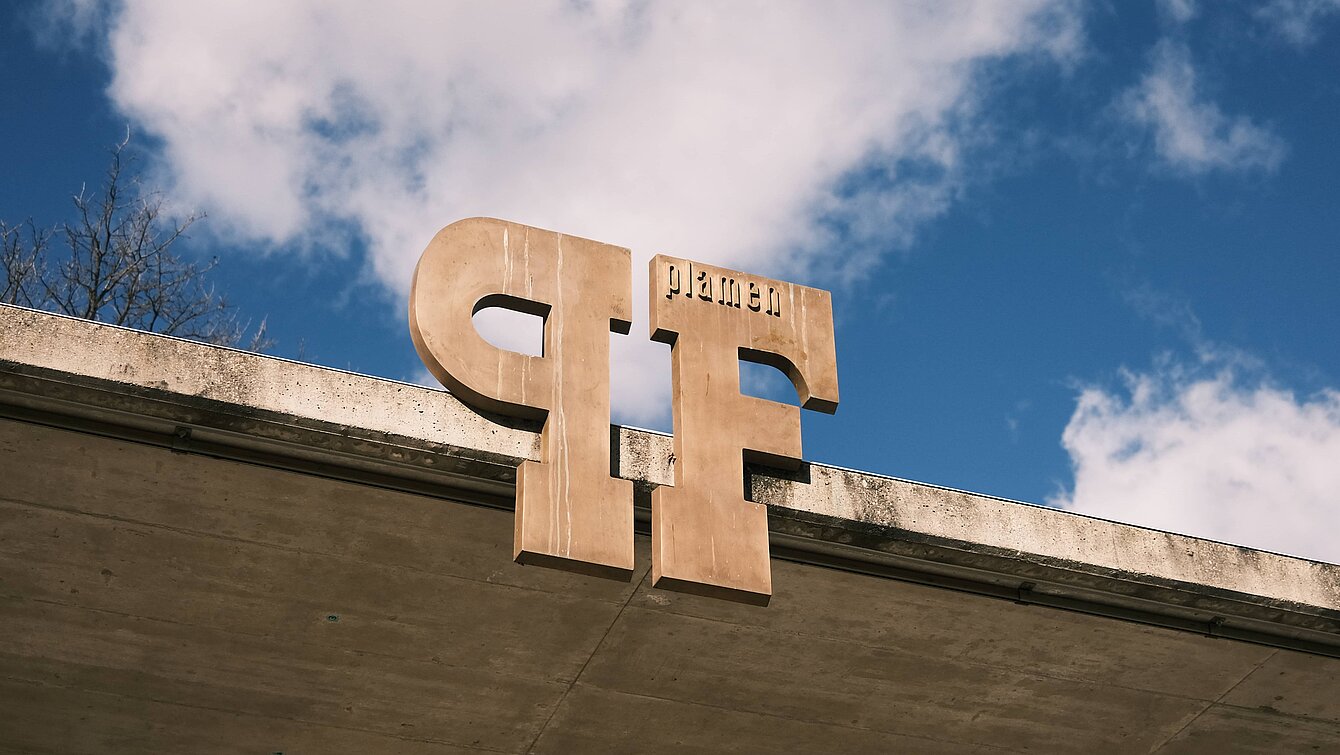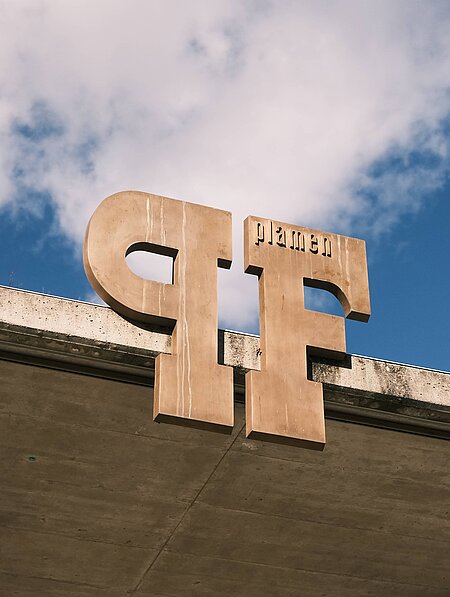Elisabeth Fiedler
Pour féliciter, pour féliciter, pour féliciter, plamen
Plamen Dejanoff, 2015


Image Credits
Show all
About the sculpture
pour féliciter
pour féliciter
pour féliciter
plamen
2015
Capital letters introduced verses at the beginning of the 5th century and their conciseness gave them special significance. They are still used today as significant abbreviations for political groups, as company logos, monograms or artistic signatures.
Two capital letters mark the flat roof of the Berggartencafé in the Austrian Sculpture Park. P and F are placed back to back in pronounced typography, with the word plamen in the F. Measuring 140 x 70 x 6 cm each, they appear as a classic sculpture in cast bronze. The division of the work into two parts is not accidental. Taken from the model, it was the P that entered the sculpture park a year ago and is now followed by the second letter as a sign of history as genesis, but also as completion of the work while at the same time being aware of the latency and fleeting nature of the word.
Writing is, as Sigmund Freud said, the language of absence. In its embodiment, it has become an altered presence in art since Minimal and Concept Art, but its referential character remains intact. Plamen Dejanoff not only refers with the two letters, he takes over, appropriates, i.e. takes the lettering from the title page of the former Czechoslovakian magazine plamen (German: Flamme) from December 1965 and transfers it from two- to three-dimensionality.
Plamen, the magazine for literature, art and life, was the Czechoslovakian organ of the platform of the same name for and by intellectuals, which was founded in 1959 and published from 1960 to 1969. Characterized by an extraordinary graphic design by typographer Odřich Hlavsa, artists, architects, writers, philosophers, sociologists and scientists such as Michel Foucault, Jean-Paul Sartre, Erich Fromm and Václav Havel exchanged ideas here and published in this medium with a circulation of 25,000 copies. Critically questioning political systems, the intelligentsia, although censored by the state, communicated via this journal. Recognized as an important starting point for the Prague Spring, it was finally banned for good. As a result, the magazine was no longer available in Prague's libraries and attempts were made to erase this part of the city's history. Significantly, Dejanoff found issues of the journal in the capitalist West, in American second-hand bookshops.
The letters P and F from the plamen 12/1965 issue, which stood for Pour Féliciter at the turn of the year, mutate in size, material and location, expand their terrain, become sculptures and are here congratulations to welcome, bid farewell and accompany all visitors.
Plamen Dejanoff is not only interested in the transformation from one medium to another, from seemingly ephemeral letters to a sculpture that appears to float despite its volume. Knowledge of the feared significance of writing and the written word for those in power is just as important as the use of different means and structures of communication. The reciprocal influence of political structures, their effects and the clash between the contexts of the Eastern Bloc and Western society is just as important as that of the intellectual world and the art market. Dejanoff's specific translation into art, which always contains references, oscillates in constant ambiguities that include market mechanisms and questions inherent to art as well as personal research.
Questioning the aura of a work of art, he examines claims to autonomy by adopting a form while at the same time elevating it in valuable materials. Pour Féliciter not only questions material values, the work is also a homage to spiritual goods that will not be lost. Dejanoff developed his bronze sculptures out of respect for the courage of the critical Plamen movement, creating a monument to it with historical, socio-political, power-questioning and personal references. In a newly accentuated way, the Plamen movement has thus returned to our consciousness. Like an archaeological find, Dejanoff uses it to unearth and reconnect history. At the same time, he is publishing a new issue of the magazine plamen, 01/15, to coincide with his exhibition at the 21er Haus in Vienna. This is both a respectful reference and catalog as well as an independent work of art that should be made freely available to all. The ennobling of the material paper in bound form is an integral factor in Plamen Dejanoff's multi-layered working method.
Receiving, accepting and passing on impulses enable both idealistic and monumental formulations, exploratory insights and utopian ventures. The fact that language correlates with form, and that intellectual, verbal and concrete realization refer to each other, is a prerequisite for Dejanoff's sensitive and precise exploration of connections, which he returns to the public in the form of his thoughts and his realizations, thus raising new questions and challenges.
Born and raised in Veliko Tarnovo, Bulgaria, in 1970, he researched the history of his family, whose now decayed and neglected properties in the former centers of Veliko Tarnovo and Arbanassi were restituted. Dejanoff set up a foundation for the general and artistic exploration of this topic.
His own name, and thus the question of the self, is also part of Plamen Dejanoff's research and work. Triggered by the strange similarity between his first name, which has only existed as such since the early 1960s, and that of the resistant magazine and group from the 1960s, he understands and sets Plamen as a parameter that he did not choose himself. The oscillation of his own person in the background and back into the foreground becomes a game that Dejanoff consciously employs.
His surname, whose spelling he changed from Dejanov to the Latin form Dejanoff after his collaboration with Svetlana Heger ended, had already been chosen by his grandfather.
Historical contexts are thus compared with a staged identity, graphic design of art, retrospection of contemporary staging and fetishisms are questioned. Complexity and exaggeration not only address the status of art, but also provoke reflections on shifts in identity and marketability. The ending of his name is reminiscent of brands such as Davidoff or Smirnoff and refers to the absurdity of capitalist systems; at the same time, one is reminded of Romanoff and, in the search for the meaning of the endings of family names, learns that -off is a possessive ending of Slavic origin or that references can be made to a place or the founder of a place.
Plamen Dejanoff thus seems to be driven less by a desire to shape society than by investigations into his own and general history in order to initiate new social possibilities. From Dejanoff's examination of social, political and economic conditions and the inclusion or exposure of his own person and history, he questions values, repositions them and thus sharpens our awareness of history, language and places. He reveals networks and wishes us all the best. Pour féliciter plamen!



















